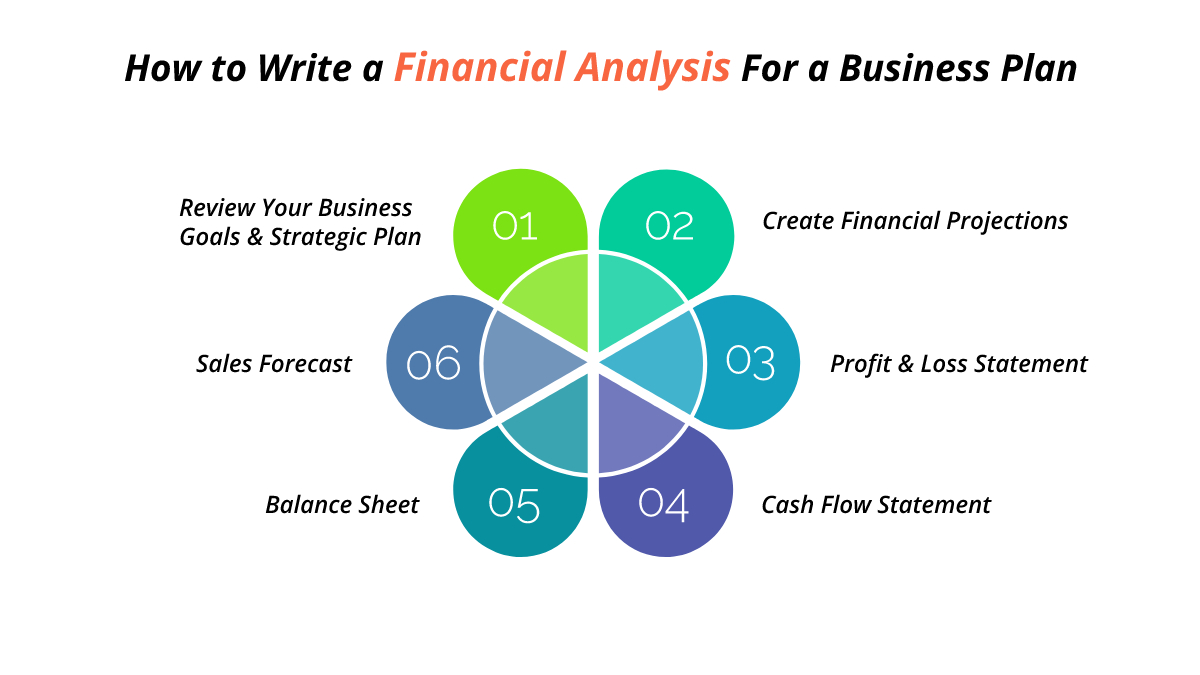How to Write the Financial Section of a Business Plan
Table of Contents
- Want to write a business plan?
- What is Financial Plan in Business Plan?
- How to Write A Business Plan Financial Section
- Review your Business Goals and Strategic Plan
- Create Financial Projections
- Profit and Loss Statement
- Profit and Loss Statement Template
- Parts of a Profit and Loss Statement
- Calculate Operating Income
- Calculate Net Income
- Cash Flow Statement
- Professional Business Templates for Small Businesses
- Difference between Cash and Accrual Accounting
- Balance Sheet
- Sales Forecast
- How To Make A Sales Forecast For A Business Plan?
- Need Business Plan Cover Page?
- Personnel Plan
- Breakeven Analysis and Business Ratios
- Use Financial Plan as a Tool for Business Management
- Frequently Asked Questions (FAQs)
When you are starting a small business or a startup, you will need to make financial projections for your business.
Financial plan in business plan helps understand the chances of your business becoming a financial success. Investors want to see a financial plan to know how much money they’ll invest and what the expected return over investment is for them.
We have briefly discussed the process of writing a financial plan in business plan. One thing that can make or break your financial plan in business plan is your honesty about numbers.
Try not to be over-optimistic. See the growth pattern of similar businesses and project closely to them. Don’t overestimate the effects of your competitive advantage.


Want to write a business plan?
Hire our top business plan writers now!
What is Financial Plan in Business Plan?
A financial plan in business plan is an overview of your business financial projections.
Business plan financial projections include financial reports including Profit & Loss, cash flow statement, and balance sheet.
A financial plan will also discuss sales forecast, employees’ salaries and other expenses forecast, business breakeven analysis, and important business rations that help measure growth.
How to Write A Business Plan Financial Section
A business plan financial section is about making simple forecasts and creating a few financial reports. You don’t need to know accounting, nor is it necessary for creating financial projections.
We have outlined and simplified the process of creating a financial plan for business plan. Simply follow the process and take help from our examples and templates to write an excellent financial plan section of a business plan.

Review your Business Goals and Strategic Plan
You have set business goals in your business plan. A strategic plan is how you will navigate to financial success.
Everything in a business plan that contributes toward your business goals. Before writing financial projections, consider these goals and milestones:
- Expansion plans
- Adding more people to your team
- Resources required to meet your business goals
- Cash flow needs of your business in the short and long term
- Financing needs to meet business goals
Create Financial Projections
Financial projections in a business plan will include the following:
- Profit and loss statement
- Cash Flow Statement
- Balance Sheet
- Sales Forecast
- Personnel Plan
- Business Ratios and Breakeven Analysis
We will explore each in detail in the following section. By the end of the article, you will fully understand how to create financial plan in business plan.
Profit and Loss Statement
A profit and loss statement is the first financial report you will create when writing financial plan in business plan.
A profit and loss statement reports your business income or loss over a certain period of time.
Profit and loss statement is also known by other names including its short form i.e., P & L statement, income statement, and pro forma income statement.
A profit and loss statement includes total revenues, expenses, and costs. A P&L statement is made for different time intervals like quarterly, bi-annual and annual. It shows net income after the cost of goods sold, expenses, taxes, depreciation, and amortization.
Before creating a P&L statement for your business, you may need to look for the right format for your business structure. For example, you will need a different format for a profit and loss statement for a sole proprietorship and a different one for an LLC.
Check income statement examples to understand and create one yourself.

Profit and Loss Statement Template
Download our free profit and loss statement templates & examples, and make a professional income statement for financial plan in business plan.
Parts of a Profit and Loss Statement
Every profit and loss statement includes the following elements:
- Total Revenues
- Expenses
- Cost of Sales or Cost of Goods Sold
- Gross Margin
Depending on the business type, a P&L statement may include insurance, taxes, depreciation, and amortization. Make sure to include a forecast for all heads in financial plan in business plan.
Calculate Operating Income
Start your profit and loss statement by calculating operating income; use this formula.
Gross Margin – Operating Expenses = Operating Income
Typically, operating income is equal to EBITDA (earnings before interest, taxes, depreciation, and amortization).
Operating income is also called the gross profit and it does not deduce taxes or other accounting adjustments from the income.
Calculate Net Income
Use this formula to calculate net income.
Operating Income – (Interest + Taxes + Depreciation + Amortization Expenses) = Net Income
Access our free sample business plans now!
Cash Flow Statement
A cash flow statement is typically prepared every month. You can create monthly and quarterly cash flow statement in financial plan in business plan.
A cash flow statement informs about the cash your business brought income, the cash it paid out, and how much is still available with the bank.
A cash flow statement gives an understanding of your income sources and expenses. When you forecast your financial reports, a cash flow statement will show your expected income sources and expenses.
A cash flow statement will help potential lenders and investors understand how you plan to make money. It provides reliable data about cash in and cash out. Keep it realistic and in line with the industry number for the most part. An exception may be an innovation or a breakthrough you bring to the market.
Your profit and cash flow are not the same. It is possible to have a cashless, profitable business or a business in loss with plenty of cash. A good cash flow helps you keep your business open and turn things around.
A cash flow statement also reflects your behavior with money. It shows if you spend on spur of the moment or think strategically.
When creating a cash flow statement in a business plan, you will need to understand two basic concepts of accounting; cash accounting and accrual accounting.

Professional Business Templates for Small Businesses
Check our extensive library of business templates for small businesses and make use of the templates and examples in writing your business plan.
Difference between Cash and Accrual Accounting
The difference between cash and accrual accounting is Accrual accounting records revenues/income and expenses when they occur while cash accounting records income/revenue and expenses when the money actually changes hands.
You will need to decide if you will use cash accounting or accrual accounting. However, the final choice will depend on your business type and product.
For example, you are selling tickets to a show or you are taking preorders for your new product. Under cash accounting, you will record all income now and expenses when you have actually shipped the product or organized the show.
However, with accrual accounting, you will record both income and expenses when you have shipped the product or held the show.
Here, cash accounting will show the months with cash abundance as profitable and the months of spending, like shipping of the products of event organization, as a loss. It is hard to see a pattern and get actionable insight with cash accounting.
It is a good time to decide about the accounting method you will use when you are writing a financial plan in business plan.
Check with your accounting consultant and discuss accrual and cash accounting to select the one most suitable for your business.
Balance Sheet
A balance sheet is a summary of the financial position of your business.
A balance sheet includes assets, liabilities, and equity. A balance sheet is based on this formula and it is always equal on both sides of the equation.
Assets = Liabilities + Equity
Here, Assets include your inventory, cash at hand and bank, property, vehicles, accounts receivables, etc. Liabilities are debts, loans and account payables. Equity includes shares proceeds, retained earnings, and owner’s money.
Download Balance Sheet Template from WiseBusinessPlan and make a balance sheet easy.
Sales Forecast
A sales forecast is your projection about the sales you will make in a certain time. Investors and lenders will be interested in seeing your sales forecast. They will estimate your chances of meeting the forecast and projections.
Keep your sales forecast consistent with the financial reports like the cash flow statement and profit & loss statement.
How To Make A Sales Forecast For A Business Plan?
First, decide the period for the sales forecast, like one month or a quarter. Then, do the following steps to make a sales forecast for that period.
- List goods or services your business sells
- Forecast sales for each product or service
- Set per unit price for your goods or services
- Find sales volume by multiplying units sold with unit price
- Calculate the cost of goods sold
- Multiply the cost of goods sold by the number of units sold, this is your total cost
- Take the total cost amount from the total sales amount

Need Business Plan Cover Page?
Download our business plan cover page now!
Personnel Plan
A personnel plan shows the costs and value of the employees you will hire.
Very small businesses, startups, or solopreneurs may not need a personnel plan but any business with employees, or plans to hire employees, will need this.
Forecast the cost of each employee and the value they will provide. You don’t need to discuss everything about employees, just do a short cost-benefit analysis for each position or employee.
Breakeven Analysis and Business Ratios
Breakeven analysis tells you the number of sales you need to bring in to cover all of your business expenses.
Use this formula to calculate the breakeven point for your business.
Break-Even Point (units) = Fixed Costs / (Sales price per unit – Variable costs per unit)
Business ratios are like signals for your business. You can quickly spot a growth or fall with a ratio. Some business ratios also help you see business health.
You are not required to include business ratio forecasts however, it is good to know about them when writing a business plan.
Here are some of the most used business ratios.
- Gross margin
- Return on sales
- Return on assets
- Return on investment
- Debt-to-equity
- Current ratio
- Working capital
- gross margin
- return on investment (ROI)
- Debt-to-equity.
Use Financial Plan as a Tool for Business Management
One mistake that most people make is thinking that building a business plan is a one time thing.
Your business plan and your financial projections can help you measure your business growth. You can use these numbers as a yard stick to see if you are meeting your projections or not. For example, if part of your funding is a bank loan, align this with a bank business plan structure to meet lender requirements.
Here is how you can your business plan as a management tool for your business.
Schedule monthly and quarterly business review meetings. Compare your actual data for that period with your forecast data and see how you are moving towards your business goals. Adjust your forecast or projections with the help of actual data to keep your growth trajectory in the right direction.
Hire our professional who can help write a business plan!
Frequently Asked Questions (FAQs)
The financial section of a business plan should include key financial statements such as the income statement, balance sheet, and cash flow statement. It should also provide details on projected sales, expenses, and profitability, along with any assumptions or financial ratios used.
Forecasting sales and revenue involves analyzing market research, understanding your target audience, and considering factors such as pricing, competition, and marketing strategies. Utilize historical data, industry benchmarks, and realistic growth assumptions to estimate future sales figures.
In addition to sales and revenue projections, the financial section should include projected expenses, such as operational costs, marketing expenses, and overheads. It should also outline anticipated profits, cash flow projections, and return on investment (ROI) calculations.
Yes, including a break-even analysis is important as it helps determine the point at which your business will start generating profits. It identifies the sales volume needed to cover all expenses and provides insights into the viability of your business.
Supporting documents may include historical financial statements, tax returns, cash flow statements, balance sheets, and any other relevant financial records. Additionally, include details about any loans, investments, or funding sources that contribute to the financial projections.

